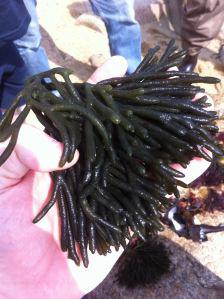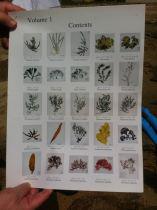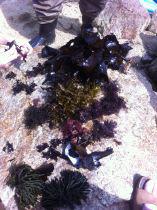
Dead man's fingers (Codium fragile) - © CJA Bradshaw
I’ve had an interesting week. First, it’s been about 6 years since I was last in Japan, and I love coming here; the food is exquisite, the people are fantastic (polite, happy, accommodating), everything works (trains, buses, etc.) and most importantly, it has an almost incredible proportion of its native forests intact.
But it wasn’t for forests that I travelled to Japan (nor the sumo currently showing on the guest-room telly where I’m staying – love the sumo): I was here for a calcareous macroalgae workshop.
What?
First, what are ‘macroalgae’, and why are some ‘calcareous’? And why should anyone in their right mind care?
Good questions. Answers: 1. Seaweeds; 2. Many incorporate calcium carbonate into their structures as added structural support; 3. Read on.
Now, I’m no phycologist (seaweed scientist), but I’m fascinated by this particular taxon. I’ve written a few posts about their vital ecological roles (see here and here), but let me regale you with some other important facts about these amazing species.

Some Japanese macroalgae - © CJA Bradshaw
There are about 12,000 known species of macroalgae described by phycologists, but as I’ve learnt this week, this is obviously a vast underestimate. For most taxa that people are investigating now using molecular techniques, the genetic diversity is so high and so geographically structured that there are obviously a huge number of ‘cryptic’ species within our current taxonomic divisions. This could mean that we’re out by up to a factor of 2 in the number of species in the world.
Another amazing fact – about 50 % of all known seaweed species are found in just two countries – Japan and Australia (hence the workshop between Japanese and Australian phycologists). Southern Australia in particular is an endemism hotspot.
Ok. Cool. So far so good. But so what?
Well, seaweeds range from the huge (e.g., bull kelp Durvillaea spp.) to the tiny (e.g., Dictyopertis spp), and they host a huge array of invertebrate and fish species. No one really knows how many, but we can consider some of the bigger species (e.g., Durvillaea, Macrocystis, etc.) as ‘the forests of the sea’, and as we know with terrestrial tree forests, when you cut them down or degrade them, millions of other species go extinct (e.g., see my previous post covering our Nature paper). For the smaller seaweed species, the number and diversity of dependent invertebrates are massive, but no one really knows how much. Regardless, we do know that when macroalgae diversity and biomass declines, marine communities lose species, and the potential corollaries include loss of fisheries production.
So we agree that this is a wonderfully diverse taxon, that it’s under-studied, and that it’s hugely important for co-dependent marine species. But what are the threats? Certainly pollution is one, and harvest is potentially another (Australians won’t really get that since we don’t tend to eat too much seaweed, but the Japanese and Chinese certainly do). Perhaps the most insidious and dangerous threat though is climate change.
Yes, that bugbear of the stupid, illogical and financially/politically motivated is, in fact, killing our seaweeds and driving biodiversity declines in our oceans.

Our haul of about 10 species of seaweed from Awaji Island near Kobe, Japan - © CJA Bradshaw
I can’t give away too many details here because a paper we’ve recently had accepted in a high-profile journal is not yet available online (and I have to respect the press embargo – you can perhaps email the lead author, Thomas Wernberg, for a pre-print), but entire seaweed communities are retreating polewards as our oceans heat up, meaning that eventually, many will become extinct (I’ll blog on that when the paper’s available). Thankfully, seaweeds are a taxon that has resisted anthropogenic drivers of extinction pretty well up until now. Alan Millar (one of the workshop participants) was the first to describe a seaweed extinction, and just told us the other day that another one in eastern Australia is now almost certainly gone. However, over the next 30-70 years we can expect hundreds, if not thousands more to go extinct merely from warming seas.
Finally, about ‘calcareous macroalgae’: these seaweeds are the primary reef builders where there is continual washing by strong wave action and currents, or in regions too deep or too cold for zoothanthella (photosynthetic protozoa)-associated corals to grow, such as coral reef crests, temperate reefs and continental shelf rhodolith beds. The importance of calcareous macroalgae in coral reef growth cannot be overstated; most reefs would not be able to survive without calcareous macroalgae, and since the centres of marine biodiversity are coral reefs, they’re pretty bloody important. And of course, because of the calcium carbonate they take up, their are also vulnerable to ocean acidification from climate change. Double whammy.
So there you have it. Much of our ignorance about this taxon is being addressed by some very clever people here at the workshop and elsewhere. I want to thank our host, Hiroshi Kawai for his insight, generosity and organisational flair, Fred Gurgel – my colleague at the University of Adelaide/DENR/SARDI for inviting me (my role was to provide an external perspective and mathematical edge), Marty Deveney, Alan Millar, John Runcie, Takeaki Hanyuda, Akira Kurihara, NiNi Win, Takahiro Yamagishi, Mitsunobu Kamiya, Rei Kojima, Ryuta Terada and the many helpful students in Kawai-San’s lab for a wonderful, insightful and productive week.
Let’s keep the analyses coming.
Before I finish, I’ll leave you with a little video I shot of a less-than-happy octopus who found his way into our collecting bucket (NB: tako is Japanese for ‘octopus’).
CJA Bradshaw
-34.917731 138.603034
